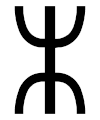Calendar stick
The calendar stick is a perpetual calendar based on the 19-year Metonic Cycle of the Moon. It is a Swedish invention, possibly a further development of older continental calendar rods. The oldest known, and only one from the Middle Ages , is the Nyköping staff, probably from the 13th century. Most of the several thousand preserved are wooden calendars from the 16th and 17th centuries. The calendar sticks were written on parchment or carved in sticks made of wood, bone or horn. During the 18th century, the rune calendars experienced a renaissance, around 1800 such calendars were made from brass as tobacco boxes.
A typical calendar stick consisted of several horizontal rows of symbols on top of each other.
In a series, 52 weeks of seven days each were represented by 52 repetitions of the first seven runes of the younger Futhark (cf. day letter ). The runes that belonged to the day of the week varied from year to year.
In another, many days were represented by one of 19 symbols representing one of the 19 golden numbers of the years of the Metonic cycle. In the early calendars, each of the nineteen years of the cycle was represented by a rune; the first 16 were the 16 runes of the younger Futhark , plus special runes for the remaining three years: Arlaug (golden number 17), Tvimadur (golden number 18), and Belgthor (golden number 19). On this day the new moon will fall in the corresponding year of the cycle . For example, in the 18th year of the cycle, the new moons will fall on all dates marked with the Tvimadur. Later calendars used numbers in the Pentesimal system for the values from 1 to 19.
Special days such as solstices , equinoxes and holidays were marked in an additional row with symbols. The calendar is independent of knowledge of the length of the tropical year or the occurrence of leap years . It was set at the beginning of the year by observing the first full moon after the winter solstice . The first full moon also marked the date of the Disting , a pagan festival and fair .
Individual evidence
- ↑ Elizabeth Svärdström: Nyköpingsstaven och de medeltida kalenderrunorna . Kunglig. Vitterhet's history and Antiqvitets academies. Antikvarisk Archive 21, Stockholm 1963.
literature
- Emil Schnippel: About a strange runic calendar (so-called Rîmstock or Primstab) from the Grand Ducal Museum in Oldenburg. In addition to introductory remarks on the most important results of recent rune research and comparative studies on the Nordic runic calendars in general. Stalling in Komm, Oldenburg 1883 ( read online ).
- Aletta Leipold: The runic calendar. Ancestral household items between paganism and Christianization. In: Heike Link, Thomas Müller-Bahlke (Ed.): Signs and Miracles. Secrets of the writing cabinet in the art and natural history chamber of the Franconian foundations. Hall 2003.



